
Catalog excerpts
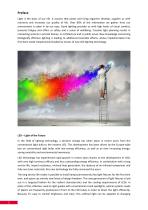
Preface Light is the basis of our life. It assures that plants and living organism develop, supplies us with nutrients and increases our quality of life. Over 80% of the information we gather from our environment is taken in by our eyes. Good lighting provides us with high levels of visual comfort, prevents fatigue and offers us safety and a sense of wellbeing. Creative light planning results in interesting accents in private homes, in architecture and in public areas. New knowledge concerning biologically effective lighting is leading to additional favorable effects, whose implementation...
Open the catalog to page 2
sunlight during the course of the day, thus increasing one’s sense of wellbeing and improving one’s performance. This biological effect of light is now being correctly understood for the first time. LEDs have thus long since gone beyond their previous status as effects lighting and are being used for display illumination, LED displays and light fixtures. Modern means of transportation, signal systems and street lights, as well as indoor and outdoor lighting, are no longer conceivable without them. New Challenges for Measuring Technology Whereas with conventional lighting technology it was...
Open the catalog to page 3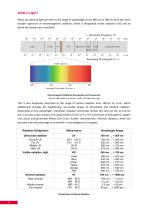
When we speak of light we refer to the range of wavelengths from 380 nm to 780 nm from the much broader spectrum of electromagnetic radiation, which is designated visible radiation (VIS) and to which the human eye is sensitive. Classification of Optical Radiation
Open the catalog to page 6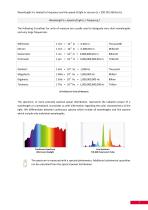
Wavelength λ is related to frequency and the speed of light in vacuum (c = 299,792.458 km/s). Wavelength λ = Speed of Light c / Frequency f The following SI prefixes for units of measure are usually used to designate very short wavelengths and very large frequencies. SI Prefixes for Units of Measure The spectrum, or more precisely spectral power distribution, represents the radiation power of a wavelength or a waveband. It provides us with information regarding the color characteristics of the light. We differentiate between continuous spectra which include all wavelengths and line spectra...
Open the catalog to page 7
Spectral Sensitivity of the Human Eye The sensitivity of the human eye to visible radiation varies depending on wavelength. Spectral sensitivity curves for the human eye have been established by the International Commission on Illumination (CIE) for the eyes of the standard observer and are standardized to a maximum value of 1. Non-standardized curves are also designated as the photometric radiation equivalent. Their maximum values are 683 lm/W for daytime vision and 1699 lm/W for night vision. In the case of daytime vision or photoptic vision, the eye is light-adapted (luminance > 30...
Open the catalog to page 8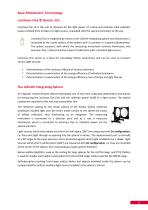
Basic Photometric Terminology Luminous Flux Φ [lumen, lm] Luminous flux Φ is the unit of measure for the light power of a lamp and indicates total radiation power emitted from all sides of a light source, evaluated with the spectral sensitivity of the eye. Luminous flux is integrated by means of an Ulbricht integrating sphere and illuminance is measured at the inside surface of the sphere with a luxmeter or a spectral photometer. The sphere constant, with which the measuring instrument converts illuminance into luminous flux, is determined by means of calibration with a standard light...
Open the catalog to page 9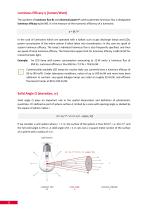
Luminous Efficacy η [lumen/Watt] The quotient of luminous flux Φ and electrical power P used to generate luminous flux is designated luminous efficacy η [lm/W]. It’s the measure of the economic efficiency of a luminaire. η=Φ/P In the case of luminaires which are operated with a ballast such as gas discharge lamps and LEDs, power consumption of the entire system if often taken into consideration. In this case we speak of system luminous efficacy. The lamp’s individual luminous flux is also frequently specified, and then we speak of lamp luminous efficacy. The theoretical upper limit for...
Open the catalog to page 10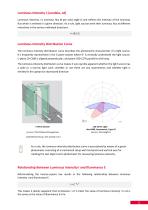
Luminous Intensity I [candela, cd] Luminous intensity I is luminous flux Φ per solid angle Ω and reflects the intensity of the luminous flux which is emitted in a given direction. As a rule, light sources emit their luminous flux at different intensities in the various individual directions. I=Φ/Ω Luminous Intensity Distribution Curve The luminous intensity distribution curve describes the photometric characteristic of a light source. It’s frequently represented in the C-plane system where 0° is vertically underneath the light source. C-plane C0-C180 is aligned perpendicular, and plane...
Open the catalog to page 11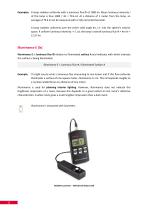
Examples: A lamp radiates uniformly with a luminous flux Φ of 1000 lm. Mean luminous intensity I of this lamp is thus 1000 / 4π = 79.6 cd. At a distance of 1 meter from the lamp, an average of 79.6 lx can be measured with a V(λ)-corrected luxmeter. A lamp radiates uniformly over the entire solid angle 4π, i.e. into the sphere’s interior space. If uniform luminous intensity I = 1 cd, the lamp’s overall luminous flux Ф = 4π lm = 12.57 lm. Illuminance E [lx] Illuminance E is luminous flux Φ relative to illuminated surface A and indicates with which intensity the surface is being illuminated....
Open the catalog to page 12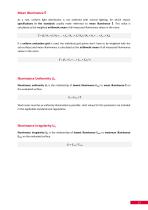
Mean Illuminance Ē As a rule, uniform light distribution is not achieved with normal lighting, for which reason specifications in the standards usually make reference to mean illuminance Ē. This value is calculated as the weighted arithmetic mean of all measured illuminance values in the room. Ē = (E1*A1 + E2*A2 + … + En-1*An-1 + En*An) / (A1 + A2 + … + An-1 + An) If a uniform evaluation grid is used, the individual grid points don’t have to be weighted with the sub-surfaces and mean illuminance is calculated as the arithmetic mean of all measured illuminance values in the room. Ē = (E1 +...
Open the catalog to page 13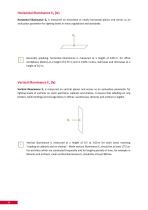
Horizontal Illuminance Eh [lx] Horizontal illuminance Eh is measured on horizontal or nearly horizontal planes and serves as an evaluation parameter for lighting levels in many regulations and standards. Generally speaking, horizontal illuminance is measured at a height of 0.85 m, for office workplaces (desks) at a height of 0.75 m and in traffic routes, staircases and driveways at a height of 0.2 m. Vertical Illuminance Ev [lx] Vertical illuminance Ev is measured on vertical planes and serves as an evaluation parameter for lighting levels of surfaces on room partitions, cabinets and...
Open the catalog to page 14All GOSSEN Foto- und Lichtmesstechnik GmbH catalogs and technical brochures
-
Catalogue "Exposure Meters"
28 Pages
-
MAVOLUX 5032 C BASE
4 Pages
-
Light Measuring
20 Pages





